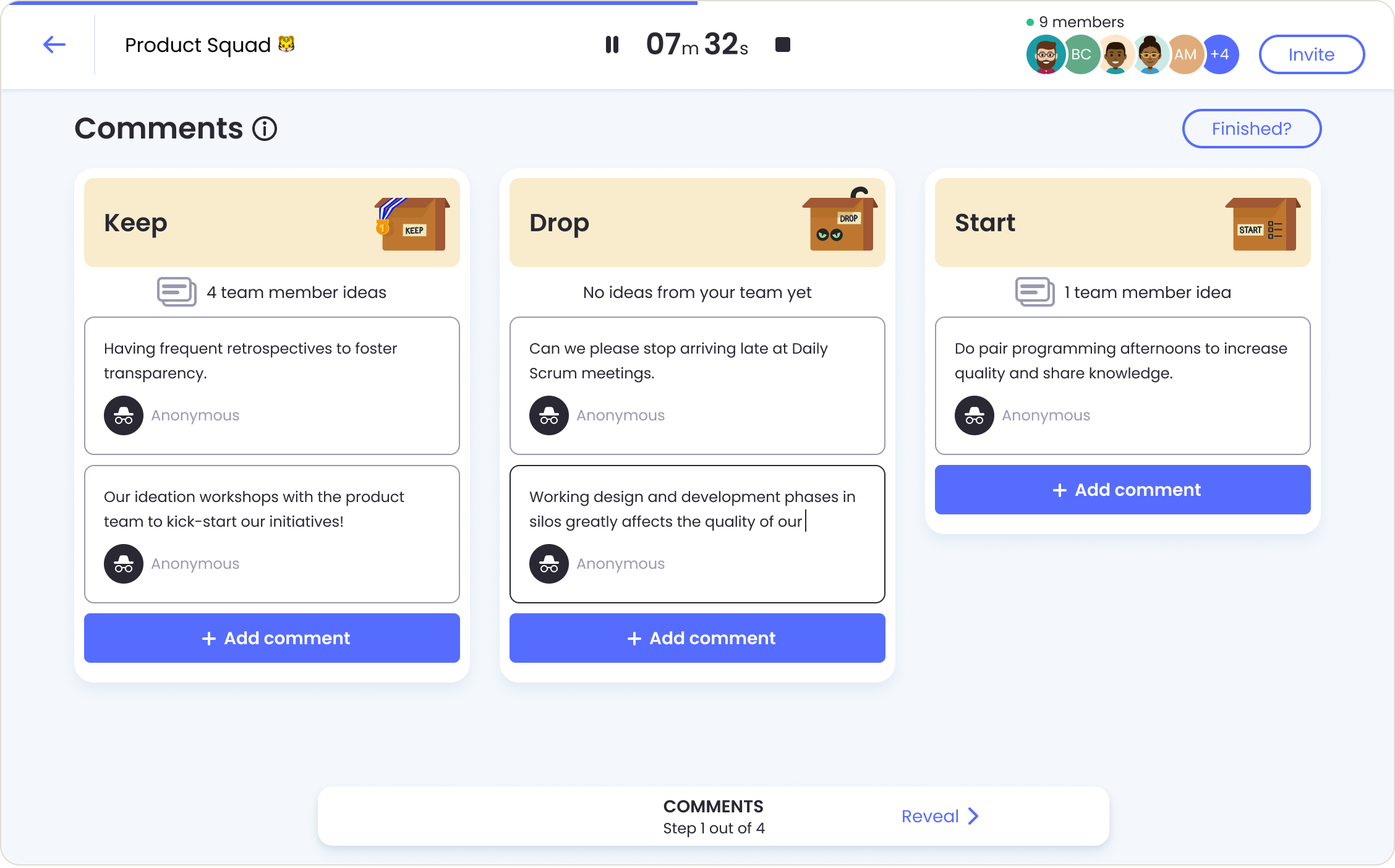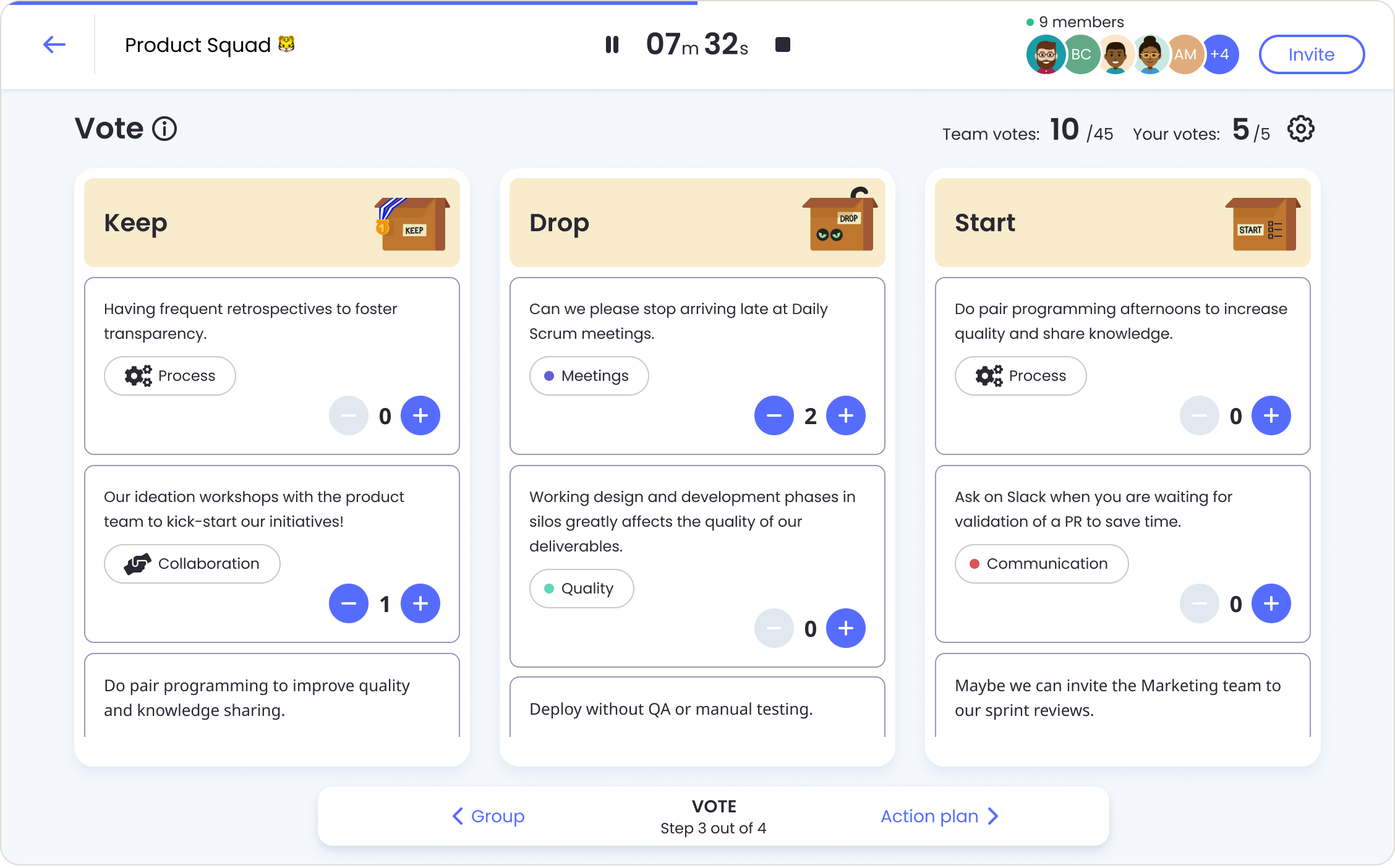How Anonymity can help with your Sprint Retrospectives


Anonymity is a great way to maintain good levels of psychological safety within the team. Especially during Sprint retrospectives. When they feel safe, people know they won't be judged for what they say, so they tend to share more freely.
But anonymous retrospectives can also have a negative impact on trust within the team. After all, how can you trust your colleagues if you don't know what they honestly think?
Anonymity is a powerful solution to help any team improve - but only if you use it smartly.
In this article, we will tackle the following questions:
When should you do an anonymous retrospective?
Anonymity is a tool that mitigates a lack of trust in the team. Note that I used 'mitigate' and not 'fix'.
Anonymity helps a team conduct productive retrospectives and talk about real issues while waiting for a climate of trust to emerge.
Here are several symptoms that indicate a potential lack of trust in your team:
People never share ideas
Ideas shared are always positive
The shared ideas are shallow issues
You perceive coldness in the team interactions
The team has a low level of psychological safety
These symptoms will diminish the value of your retrospectives, waste your team's time and prevent people from improving.
Moreover, these issues don't just affect the idea-sharing phase of your retrospective; they can also harm other stages of your meeting.
What data can be anonymized in a retrospective?
Based on my experience, three core retrospective stages can use anonymity:
Ideas collection
Vote
By the way, you can choose to anonymize only one of them. So the whole retrospective does not have to be 100% anonymous.
The same rule applies in stages where your team can share their ideas. Nothing should force them to post all their opinions anonymously. I frankly believe anonymity should remain an option for every single idea a team member can share.
Ideas collection
Collecting ideas means sharing feedback. The purpose here is to give each team member a moment of personal reflection.
This reflection allows them to think about what happened during the last Sprint and express their remarks, comments, opinions, or feelings.
Members must feel psychologically safe to get the most out of this phase. If not, they will fear others' judgment and won't share their genuine problems.
In this context, anonymity can be helpful. By anonymizing feedback, you increase people's chances of talking about what really matters, even if it's about sensitive topics.
As the team's facilitator or Scrum Master, use your knowledge of each person. The more you know about your team members, the more likely you'll detect if people hold back stuff because they don't feel safe enough.
If the real issues come out, or you sense courage and vulnerability in the ideas being shared, it means anonymity works. It's up to you to experiment and make future retrospectives in non-anonymous mode to compare the quality of the team's feedback.
Vote
During the voting stage, team members should not influence each other. Just because the Tech Lead or Product Owner votes on an idea doesn't mean it's more important than the others.
“When people can see other people’s votes before they themselves vote, they sometimes cast a political vote, or a politically correct vote, rather than one that reflects their true opinion.”
- Aino Vonge Corry, Retrospectives Antipatterns
Anonymity gives every vote the same value. In a retrospective, we want to know what the team considers to be its priority, so one voice is not worth more than another.
Regardless of the context, this step should be anonymous and personal. It is also necessary to avoid groupthink, a.k.a pushing people to vote for the most popular ideas.
ROTI
ROTI stands for 'Return on Time Invested'. It takes place at the end of the retrospective and allows the team to evaluate the retrospective's efficiency. Also, this technique helps teams improve the way they run retrospectives.
We begin by giving a score from 1 to 5 to the retrospective. Then each member can leave a comment to provide context to their score.
Anonymity is strongly advised for this phase. Doing so allows people to share feedback without thinking about the team's judgment or the facilitator's opinion.
Just like in the voting phase, anonymity ensures that one score does not count more than another. Again, the team's opinion is the only thing that matters.
What risks come with anonymity?
Anonymity is a means to an end, not an end in itself. Therefore, the intent of each team should be to use it as little as possible.
"When these values (Commitment, Focus, Openness, Respect, and Courage) are embodied by the Scrum Team and the people they work with, the empirical Scrum pillars of transparency, inspection, and adaptation come to life building trust."
Scrum emphasizes values like courage and trust. These values are the foundations of a successful team. Using anonymity too often will prevent you from cultivating them.
It takes courage to make yourself vulnerable and tell the team what you genuinely think. Anonymity creates a wall to hide behind during the retro. A team must be able to address the most sensitive topics without hiding.
If you wish to create real cohesion in the team, it is essential to know what problems people have... and what they really think.
How to make a retrospective anonymous?
The best way to anonymize the stages of your retrospective is to use a retrospective tool.
So we'll use Neatro to show you how to anonymize your retrospective comments, votes, and ROTI.
Comments
Anonymizing comments with Neatro is super simple. Just before you launch the retrospective, you can make all comments anonymous by default in one click!

Comments will display as follows in each step of the retrospective:

Only the logged-in person's comments are displayed in this step. You can't see what other members are writing. This experience guarantees you'll never promote groupthink in your retrospective.
Even if you decide to do a non-anonymous retrospective, team members can toggle anonymity on each comment.
Vote
By default, voting is anonymous and individual in Neatro. Consequently, during reflection, team members cannot see the other votes.
Once the votes are revealed, it is impossible to know who specifically voted on a given comment.

ROTI
Just like the voting phase, Neatro's ROTI is completely anonymized. Therefore, knowing who shared a particular rating or feedback is impossible.
This portion of the Neatro experience allows you to focus on team reviews in general - and not reviews from individuals.

You now have all the cards in hand to anonymize your next retrospective. Comments, votes, or ROTI, each stage has its own problems. And anonymity can help you solve them.
Remember that you should use anonymous retrospectives as little as possible if you want to foster courage and trust in your team.
I wish you a fruitful retrospective!



